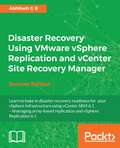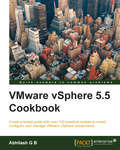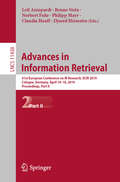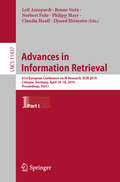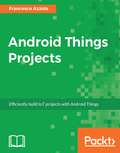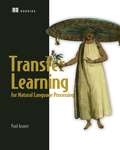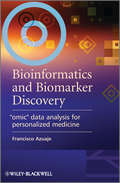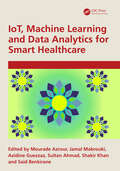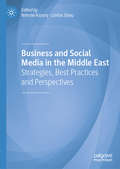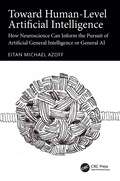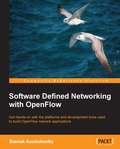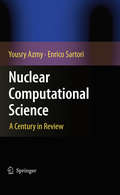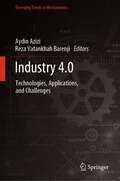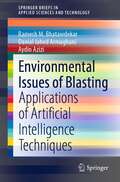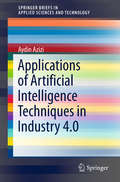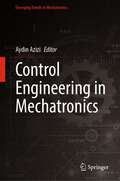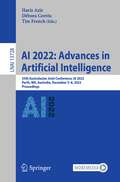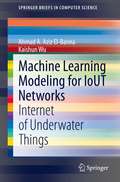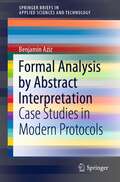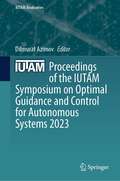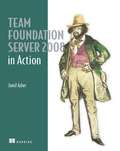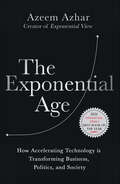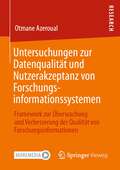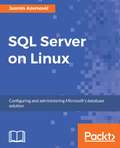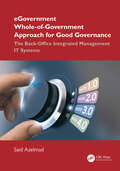- Table View
- List View
Disaster Recovery Using VMware vSphere Replication and vCenter Site Recovery Manager - Second Edition
by Abhilash G BLearn to bake in disaster recovery readiness for your vSphere Infrastructure using vCenter SRM 6.1, leveraging array-based replication and vSphere Replication 6.1 About This Book * This is the first book on the market that provides an extensive disaster recovery solution using the latest vSphere Replication and vCenter Site Recovery Manager * Master the skills of protecting your virtual machines by replicating and recovering them in seconds * This practical, step-by-step guide will help you protect all your applications with Site Recovery Manager and Replication Who This Book Is For If you are a system administrator who is looking for a disaster recovery solution using the latest VMware vSphere Replication and vCenter Site Recovery Manager, this book is perfect for you. You should have a basic knowledge of virtual machines and data center operations. What You Will Learn * Familiarize yourself with disaster recovery concepts and the architecture of vCenter Site Recovery Manager and vSphere Replication. * Deploy and Configure vCenter Site Recovery Manager to leverage array-based replication and vSphere Replication. * Use vSphere Replication as a standalone disaster recovery solution. * Enabling protection of Virtual Machines by creating Protection Groups. * Enable orchestration of the recovery of protected virtual machines by creating Recovery Plans. * Migrate virtual machine workload from one site to another using Recovery Plans * Testing and Performing a failover or failback of Virtual Machines using Recovery Plans * Enable vRealize Orchestrator Plugins for SRM and vSphere Replication. In Detail VMware vCenter Site Recovery manage is an orchestration tool used to automate disaster recovery in a manner that no other solution does. It is programmed to leverage array-based replication and VMware's proprietary vSphere Replication engine. The book begins by talking about the architecture of SRM and guides you through the procedures involved in installing and configuring SRM to leverage array-based replication. You will then learn how to protect your virtual machines by creating Protection Groups and validate their recoverability by testing recovery plans and even performing failover and failback. Moving on, you will learn how to install and configure vSphere Replication as a standalone disaster recovery solution. It also guides you through the procedures involved in configuring SRM to leverage vSphere replication. Finally, you will learn how to deploy and configure vRealize Orchestrator and its plugin for SRM and vSphere Replication. Style and approach This is a practical, step-by-step guide on implementing a disaster recovery solution for your organization using VMware vSphere Replication and vCenter Site Recovery Manager.
VMware vSphere 5.5 Cookbook
by Abhilash G BThis is an excellent handbook for system administrators, support professionals, or for anyone intending to give themselves a headstart in learning how to install, configure, and manage a vSphere environment. It is also a good task-oriented reference guide for consultants or infrastructure architects who design and deploy vSphere environments.
Advances in Information Retrieval: 41st European Conference on IR Research, ECIR 2019, Cologne, Germany, April 14–18, 2019, Proceedings, Part II (Lecture Notes in Computer Science #11438)
by Leif Azzopardi Benno Stein Norbert Fuhr Philipp Mayr Claudia Hauff Djoerd HiemstraThis two-volume set LNCS 11437 and 11438 constitutes the refereed proceedings of the 41st European Conference on IR Research, ECIR 2019, held in Cologne, Germany, in April 2019. The 48 full papers presented together with 2 keynote papers, 44 short papers, 8 demonstration papers, 8 invited CLEF papers, 11 doctoral consortium papers, 4 workshop papers, and 4 tutorials were carefully reviewed and selected from 365 submissions. They were organized in topical sections named: Modeling Relations; Classification and Search; Recommender Systems; Graphs; Query Analytics; Representation; Reproducibility (Systems); Reproducibility (Application); Neural IR; Cross Lingual IR; QA and Conversational Search; Topic Modeling; Metrics; Image IR; Short Papers; Demonstration Papers; CLEF Organizers Lab Track; Doctoral Consortium Papers; Workshops; and Tutorials.
Advances in Information Retrieval: 41st European Conference on IR Research, ECIR 2019, Cologne, Germany, April 14–18, 2019, Proceedings, Part I (Lecture Notes in Computer Science #11437)
by Leif Azzopardi Benno Stein Norbert Fuhr Philipp Mayr Claudia Hauff Djoerd HiemstraThis two-volume set LNCS 11437 and 11438 constitutes the refereed proceedings of the 41st European Conference on IR Research, ECIR 2019, held in Cologne, Germany, in April 2019. The 48 full papers presented together with 2 keynote papers, 44 short papers, 8 demonstration papers, 8 invited CLEF papers, 11 doctoral consortium papers, 4 workshop papers, and 4 tutorials were carefully reviewed and selected from 365 submissions. They were organized in topical sections named: Modeling Relations; Classification and Search; Recommender Systems; Graphs; Query Analytics; Representation; Reproducibility (Systems); Reproducibility (Application); Neural IR; Cross Lingual IR; QA and Conversational Search; Topic Modeling; Metrics; Image IR; Short Papers; Demonstration Papers; CLEF Organizers Lab Track; Doctoral Consortium Papers; Workshops; and Tutorials.
Android Things Projects
by Francesco AzzolaDevelop smart Internet of things projects using Android Things. About This Book • Learn to build promising IoT projects with Android Things • Make the most out of hardware peripherals using standard Android APIs • Build enticing projects on IoT, home automation, and robotics by leveraging Raspberry Pi 3 and Intel Edison Who This Book Is For This book is for Android enthusiasts, hobbyists, IoT experts, and Android developers who want to gain a deeper knowledge of Android Things. The main focus is on implementing IoT projects using Android Things. What You Will Learn • Understand IoT ecosystem and the Android Things role • See the Android Things framework: installation, environment, SDK, and APIs • See how to effectively use sensors (GPIO and I2C Bus) • Integrate Android Things with IoT cloud platforms • Create practical IoT projects using Android Things • Integrate Android Things with other systems using standard IoT protocols • Use Android Things in IoT projects In Detail Android Things makes developing connected embedded devices easy by providing the same Android development tools, best-in-class Android framework, and Google APIs that make developers successful on mobile. With this book, you will be able to take advantage of the new Android framework APIs to securely build projects using low-level components such as sensors, resistors, capacitors, and display controllers. This book will teach you all you need to know about working with Android Things through practical projects based on home automation, robotics, IoT, and so on. We'll teach you to make the most of the Android Things and build enticing projects such as a smart greenhouse that controls the climate and environment automatically. You'll also create an alarm system, integrate Android Things with IoT cloud platforms, and more. By the end of this book, you will know everything about Android Things, and you'll have built some very cool projects using the latest technology that is driving the adoption of IoT. You will also have primed your mindset so that you can use your knowledge for profitable, practical projects. Style and approach This book is packed with fun-filled, end-to-end projects that you will be encouraged to experiment on the Android Things OS.
Transfer Learning for Natural Language Processing
by Paul AzunreBuild custom NLP models in record time by adapting pre-trained machine learning models to solve specialized problems.Summary In Transfer Learning for Natural Language Processing you will learn: Fine tuning pretrained models with new domain data Picking the right model to reduce resource usage Transfer learning for neural network architectures Generating text with generative pretrained transformers Cross-lingual transfer learning with BERT Foundations for exploring NLP academic literature Training deep learning NLP models from scratch is costly, time-consuming, and requires massive amounts of data. In Transfer Learning for Natural Language Processing, DARPA researcher Paul Azunre reveals cutting-edge transfer learning techniques that apply customizable pretrained models to your own NLP architectures. You&’ll learn how to use transfer learning to deliver state-of-the-art results for language comprehension, even when working with limited label data. Best of all, you&’ll save on training time and computational costs. Purchase of the print book includes a free eBook in PDF, Kindle, and ePub formats from Manning Publications. About the technology Build custom NLP models in record time, even with limited datasets! Transfer learning is a machine learning technique for adapting pretrained machine learning models to solve specialized problems. This powerful approach has revolutionized natural language processing, driving improvements in machine translation, business analytics, and natural language generation. About the book Transfer Learning for Natural Language Processing teaches you to create powerful NLP solutions quickly by building on existing pretrained models. This instantly useful book provides crystal-clear explanations of the concepts you need to grok transfer learning along with hands-on examples so you can practice your new skills immediately. As you go, you&’ll apply state-of-the-art transfer learning methods to create a spam email classifier, a fact checker, and more real-world applications. What's inside Fine tuning pretrained models with new domain data Picking the right model to reduce resource use Transfer learning for neural network architectures Generating text with pretrained transformers About the reader For machine learning engineers and data scientists with some experience in NLP. About the author Paul Azunre holds a PhD in Computer Science from MIT and has served as a Principal Investigator on several DARPA research programs. Table of Contents PART 1 INTRODUCTION AND OVERVIEW 1 What is transfer learning? 2 Getting started with baselines: Data preprocessing 3 Getting started with baselines: Benchmarking and optimization PART 2 SHALLOW TRANSFER LEARNING AND DEEP TRANSFER LEARNING WITH RECURRENT NEURAL NETWORKS (RNNS) 4 Shallow transfer learning for NLP 5 Preprocessing data for recurrent neural network deep transfer learning experiments 6 Deep transfer learning for NLP with recurrent neural networks PART 3 DEEP TRANSFER LEARNING WITH TRANSFORMERS AND ADAPTATION STRATEGIES 7 Deep transfer learning for NLP with the transformer and GPT 8 Deep transfer learning for NLP with BERT and multilingual BERT 9 ULMFiT and knowledge distillation adaptation strategies 10 ALBERT, adapters, and multitask adaptation strategies 11 Conclusions
Bioinformatics and Biomarker Discovery
by Francisco AzuajeThis book is designed to introduce biologists, clinicians and computational researchers to fundamental data analysis principles, techniques and tools for supporting the discovery of biomarkers and the implementation of diagnostic/prognostic systems.The focus of the book is on how fundamental statistical and data mining approaches can support biomarker discovery and evaluation, emphasising applications based on different types of "omic" data. The book also discusses design factors, requirements and techniques for disease screening, diagnostic and prognostic applications.Readers are provided with the knowledge needed to assess the requirements, computational approaches and outputs in disease biomarker research. Commentaries from guest experts are also included, containing detailed discussions of methodologies and applications based on specific types of "omic" data, as well as their integration. Covers the main range of data sources currently used for biomarker discoveryCovers the main range of data sources currently used for biomarker discoveryPuts emphasis on concepts, design principles and methodologies that can be extended or tailored to more specific applicationsOffers principles and methods for assessing the bioinformatic/biostatistic limitations, strengths and challenges in biomarker discovery studiesDiscusses systems biology approaches and applicationsIncludes expert chapter commentaries to further discuss relevance of techniques, summarize biological/clinical implications and provide alternative interpretations
IoT, Machine Learning and Data Analytics for Smart Healthcare
by Mourade Azrour Jamal Mabrouki Azidine Guezzaz Sultan Ahmad Shakir Khan Said BenkiraneMachine learning, Internet of Things (IoT) and data analytics are new and fresh technologies that are being increasingly adopted in the field of medicine. This book positions itself at the forefront of this movement, exploring the beneficial applications of these new technologies and how they are gradually creating a smart healthcare system. This book details the various ways in which machine learning, data analytics and IoT solutions are instrumental in disease prediction in smart healthcare. For example, wearable sensors further help doctors and healthcare managers to monitor patients remotely and collect their health parameters in real-time, which can then be used to create datasets to develop machine learning models that can aid in the prediction and detection of any susceptible disease. In this way, smart healthcare can provide novel solutions to traditional medical issues. This book is a useful overview for scientists, researchers, practitioners and academics specialising in the field of intelligent healthcare, as well as containing additional appeal as a reference book for undergraduate and graduate students
Business and Social Media in the Middle East: Strategies, Best Practices and Perspectives
by Nehme Azoury Lindos DaouThis book discusses the effectiveness of Western organizations’ social media strategies in the Middle East. Social media has changed the rules of doing business, but the exact impacts vary across regions. In the context of Middle Eastern societies, social media is seen as a way for individuals and communities to communicate with each other and is generally not viewed as a means for brands to interact with individuals. Examining how the use of social media in the Middle East is shaped by the region’s culture, authors discuss the factors that businesses need to consider when creating digital marketing strategies targeted there. Including case studies of Middle Eastern companies, this book provides a comprehensive analysis of the rise of social media in the MENA region and the often-neglected role of culture in research in this area. It will provide researchers and practitioners with a deeper understanding of conducting business in the Middle East through the effective and efficient use of social media.
Toward Human-Level Artificial Intelligence: How Neuroscience Can Inform the Pursuit of Artificial General Intelligence or General AI
by Eitan Michael AzoffIs a computer simulation of a brain sufficient to make it intelligent? Do you need consciousness to have intelligence? Do you need to be alive to have consciousness? This book has a dual purpose. First, it provides a multi-disciplinary research survey across all branches of neuroscience and AI research that relate to this book’s mission of bringing AI research closer to building a human-level AI (HLAI) system. It provides an encapsulation of key ideas and concepts, and provides all the references for the reader to delve deeper; much of the survey coverage is of recent pioneering research. Second, the final part of this book brings together key concepts from the survey and makes suggestions for building HLAI. This book provides accessible explanations of numerous key concepts from neuroscience and artificial intelligence research, including: The focus on visual processing and thinking and the possible role of brain lateralization toward visual thinking and intelligence. Diffuse decision making by ensembles of neurons. The inside-out model to give HLAI an inner "life" and the possible role for cognitive architecture implementing the scientific method through the plan-do-check-act cycle within that model (learning to learn). A neuromodulation feature such as a machine equivalent of dopamine that reinforces learning. The embodied HLAI machine, a neurorobot, that interacts with the physical world as it learns. This book concludes by explaining the hypothesis that computer simulation is sufficient to take AI research further toward HLAI and that the scientific method is our means to enable that progress. This book will be of great interest to a broad audience, particularly neuroscientists and AI researchers, investors in AI projects, and lay readers looking for an accessible introduction to the intersection of neuroscience and artificial intelligence.
Software Defined Networking with OpenFlow
by Siamak AzodolmolkyA step-by-step, example-based guide which will help you gain hands-on experience with the platforms and debugging tools on OpenFlow.If you are a network engineer, architect, junior researcher or an application developer, this book is ideal for you. You will need to have some level of network experience, knowledge of broad networking concepts, and some familiarity with day- to- day operation of computer networks. Ideally, you should also be familiar with programing scripting/languages (especially Python and Java), and system virtualization.
Nuclear Computational Science
by Yousry Azmy Enrico SartoriNuclear engineering has undergone extensive progress over the years. In the past century, colossal developments have been made and with specific reference to the mathematical theory and computational science underlying this discipline, advances in areas such as high-order discretization methods, Krylov Methods and Iteration Acceleration have steadily grown. Nuclear Computational Science: A Century in Review addresses these topics and many more; topics which hold special ties to the first half of the century, and topics focused around the unique combination of nuclear engineering, computational science and mathematical theory. Comprising eight chapters, Nuclear Computational Science: A Century in Review incorporates a number of carefully selected issues representing a variety of problems, providing the reader with a wealth of information in both a clear and concise manner. The comprehensive nature of the coverage and the stature of the contributing authors combine to make this a unique landmark publication. Targeting the medium to advanced level academic, this book will appeal to researchers and students with an interest in the progression of mathematical theory and its application to nuclear computational science.
Industry 4.0: Technologies, Applications, and Challenges (Emerging Trends in Mechatronics)
by Aydin Azizi Reza Vatankhah BarenjiThis book presents Industry 4.0 enabler technologies and tools. It also highlights some of the existing empirical applications in the context of manufacturing. The book elucidates innovative thematic concepts of Industry 4.0 and its perspectives. It establishes routes to empirically utilize Industry 4.0 standards for manufacturing companies. The book can be used as a reference for professionals/engineers, researchers, and students.
Environmental Issues of Blasting: Applications of Artificial Intelligence Techniques (SpringerBriefs in Applied Sciences and Technology)
by Aydin Azizi Danial Jahed Armaghani Ramesh M. BhatawdekarThis book gives a rigorous and up-to-date study of the various AI and machine learning algorithms for resolving environmental challenges associated with blasting. Blasting is a critical activity in any mining or civil engineering project for breaking down hard rock masses. A small amount of explosive energy is only used during blasting to fracture rock in order to achieve the appropriate fragmentation, throw, and development of muck pile. The surplus energy is transformed into unfavourable environmental effects such as back-break, flyrock, air overpressure, and ground vibration. The advancement of artificial intelligence and machine learning techniques has increased the accuracy of predicting these environmental impacts of blasting. This book discusses the effective application of these strategies in forecasting, mitigating, and regulating the aforementioned blasting environmental hazards.
Applications of Artificial Intelligence Techniques in Industry 4.0 (SpringerBriefs in Applied Sciences and Technology)
by Aydin AziziThis book is to presents and evaluates a way of modelling and optimizing nonlinear RFID Network Planning (RNP) problems using artificial intelligence techniques. It uses Artificial Neural Network models (ANN) to bind together the computational artificial intelligence algorithm with knowledge representation an efficient artificial intelligence paradigm to model and optimize RFID networks.This effort leads to proposing a novel artificial intelligence algorithm which has been named hybrid artificial intelligence optimization technique to perform optimization of RNP as a hard learning problem. This hybrid optimization technique consists of two different optimization phases. First phase is optimizing RNP by Redundant Antenna Elimination (RAE) algorithm and the second phase which completes RNP optimization process is Ring Probabilistic Logic Neural Networks (RPLNN). The hybrid paradigm is explored using a flexible manufacturing system (FMS) and the results are compared with well-known evolutionary optimization technique namely Genetic Algorithm (GA) to demonstrate the feasibility of the proposed architecture successfully.
Control Engineering in Mechatronics (Emerging Trends in Mechatronics)
by Aydin AziziThis book focusses on Industry 4.0 which is one of the most challenging trends for all categories of manufacturing enterprises. In this book, variety of mechatronic solutions are discussed to develop a manufacturing control system for small and medium-sized enterprises as they impose to improve their capabilities by integration into Industry 4.0 standards.
AI 2022: 35th Australasian Joint Conference, AI 2022, Perth, WA, Australia, December 5–8, 2022, Proceedings (Lecture Notes in Computer Science #13728)
by Haris Aziz Débora Corrêa Tim FrenchThis book constitutes the refereed proceedings of the 35th Australasian Joint Conference on Artificial Intelligence, AI 2022, which took place in Perth, WA, Australia, in December 5–8, 2022. The 56 full papers included in this book were carefully reviewed and selected from 90 submissions. They were organized in topical sections as follows: Computer Vision; Deep Learning; Ethical/Explainable AI; Genetic Algorithms; Knowledge Representation and NLP; Machine Learning; Medical AI; Optimization; and Reinforcement Learning.
Machine Learning Modeling for IoUT Networks: Internet of Underwater Things (SpringerBriefs in Computer Science)
by Ahmad A. Aziz El-Banna Kaishun WuThis book discusses how machine learning and the Internet of Things (IoT) are playing a part in smart control of underwater environments, known as Internet of Underwater Things (IoUT). The authors first present seawater’s key physical variables and go on to discuss opportunistic transmission, localization and positioning, machine learning modeling for underwater communication, and ongoing challenges in the field. In addition, the authors present applications of machine learning techniques for opportunistic communication and underwater localization. They also discuss the current challenges of machine learning modeling of underwater communication from two communication engineering and data science perspectives.
Formal Analysis by Abstract Interpretation: Case Studies in Modern Protocols (SpringerBriefs in Applied Sciences and Technology)
by Benjamin AzizThe book provides a gentle introduction and definition of the denotational-based abstract interpretation method. The book demonstrates how the above method of formal analysis can be used, not only to address the security of systems, but other more general and interesting properties related to the testing, mutating and semantic ambiguity resolution of protocols. The book presents three case studies, all related to current complex protocols and standards used in industry, particularly in the context of IoT and Industry 4.0.
Proceedings of the IUTAM Symposium on Optimal Guidance and Control for Autonomous Systems 2023 (IUTAM Bookseries #40)
by Dilmurat AzimovThis book showcases a collection of papers that present cutting-edge studies, methods, experiments, and applications in various interdisciplinary fields. These fields encompass optimal control, guidance, navigation, game theory, stability, nonlinear dynamics, robotics, sensor fusion, machine learning, and autonomy. The chapters reveal novel studies and methods, providing fresh insights into the field of optimal guidance and control for autonomous systems. The book also covers a wide range of relevant applications, showcasing how optimal guidance and control techniques can be effectively applied in various domains, including mechanical and aerospace engineering. From robotics to sensor fusion and machine learning, the papers explore the practical implications of these techniques and methodologies.
Team Foundation Server 2008 in Action
by Jamil AzherIn complex software projects, managing the development process can be as critical to success as writing the code itself. A project may involve dozens of developers, managers, architects, testers, and customers, hundreds of builds, and thousands of opportunities to get off-track. To keep tabs on the people, tasks, and components of a medium- to large-scale project, most teams use a development system that allows for easy monitoring, follow-up, and accountability.Microsoft Team Foundation Server 2008 (TFS), the server component of Microsoft's Visual Studio Team System (VSTS), provides a powerful collaborative platform for software-development teams. The product offers an integrated toolset for tracking work items, creating test cases, managing source code, generating builds, constructing database schemas, and so on. Because in software development one size does not fit all, TFS provides process customization, project management, and reporting capabilities to build solutions around your requirements.Team Foundation Server 2008 in Action is a hands-on guide to Team Foundation Server 2008. Written for developers with a good handle on TFS basics, this book shows you how to solve real-life problems. It's not a repetition of Microsoft's product documentation. Team Foundation Server 2008 in Action is a practitioner's handbook for how to work with TFS under common constraints. This book walks you through real-life software engineering problems based on hundreds of hours of TFS experience.You'll benefit from expert author Jamil Azher's extensive interactions with members of Microsoft's TFS team and MVPs, survey feedback from the author's blog, and interviews with organizations and user groups using TFS. Instead of just offering a high-level overview, the book provides detailed solutions for solving common-and not-so-common-problems using TFS. It discusses the strengths as well as weaknesses of TFS, and suggests appropriate problem resolution steps, workarounds, or custom solutions. Purchase of the print book comes with an offer of a free PDF, ePub, and Kindle eBook from Manning. Also available is all code from the book.
The Exponential Age: How Accelerating Technology is Transforming Business, Politics and Society
by Azeem Azhar*2021 Financial Times Best Book of the Year* A bold exploration and call-to-arms over the widening gap between AI, automation, and big data—and our ability to deal with its effects We are living in the first exponential age. High-tech innovations are created at dazzling speeds; technological forces we barely understand remake our homes and workplaces; centuries-old tenets of politics and economics are upturned by new technologies. It all points to a world that is getting faster at a dizzying pace. Azeem Azhar, renowned technology analyst and host of the Exponential View podcast, offers a revelatory new model for understanding how technology is evolving so fast, and why it fundamentally alters the world. He roots his analysis in the idea of an “exponential gap” in which technological developments rapidly outpace our society’s ability to catch up. Azhar shows that this divide explains many problems of our time—from political polarization to ballooning inequality to unchecked corporate power. With stunning clarity of vision, he delves into how the exponential gap is a near-inevitable consequence of the rise of AI, automation, and other exponential technologies, like renewable energy, 3D printing, and synthetic biology, which loom over the horizon. And he offers a set of policy solutions that can prevent the growing exponential gap from fragmenting, weakening, or even destroying our societies. The result is a wholly new way to think about technology, one that will transform our understanding of the economy, politics, and the future.
Untersuchungen zur Datenqualität und Nutzerakzeptanz von Forschungsinformationssystemen: Framework zur Überwachung und Verbesserung der Qualität von Forschungsinformationen
by Otmane AzeroualIn der vorliegenden Arbeit wird die Datenqualität eines Forschungsinformationssystems (FIS) bzw. deren Einfluss auf die Nutzerakzeptanz ganzheitlich untersucht. Otmane Azeroual entwickelt hierfür ein Konzept bzw. ein Framework zur Überwachung und Verbesserung der Datenqualität, um die Akzeptanz des FIS zu erhöhen.
SQL Server on Linux
by Jasmin AzemovicBring the performance and security of SQL Server to Linux About This Book • Design and administer your SQL Server solution on the open source Linux platform • Install, configure, and fine-tune your database application for maximum performance • An easy-to-follow guide teaching you how to implement various SQL Server CTP 2.x offerings on Linux—from installation to administration Who This Book Is For This book is for the Linux users who want to learn SQL Server on their favorite Linux distributions. It is not important if you are experienced database user or a beginner as we are starting from scratch. However, it is recommended that you have basic knowledge about relational models. More advanced readers can pick the chapters of their interest and study specific topics immediately. Users from Windows platform can also benefit from this book to expand their frontiers and become equally efficient on both platforms. What You Will Learn • Install and set up SQL Server CTP 2.x on Linux • Create and work with database objects using SQL Server on Linux • Configure and administer SQL Server on Linux-based systems • Create and restore database back-ups • Protect sensitive data using the built-in cryptographic features • Optimize query execution using indexes • Improve query execution time by more than 10x using in-memory OLTP • Track row-versioning using temporal tables In Detail Microsoft's launch of SQL Server on Linux has made SQL Server a truly versatile platform across different operating systems and data-types, both on-premise and on-cloud. This book is your handy guide to setting up and implementing your SQL Server solution on the open source Linux platform. You will start by understanding how SQL Server can be installed on supported and unsupported Linux distributions. Then you will brush up your SQL Server skills by creating and querying database objects and implementing basic administration tasks to support business continuity, including security and performance optimization. This book will also take you beyond the basics and highlight some advanced topics such as in-memory OLTP and temporal tables. By the end of this book, you will be able to recognize and utilize the full potential of setting up an efficient SQL Server database solution in your Linux environment. Style and approach This book follows a step-by-step approach to teach readers the concepts of SQL Server on Linux using the bash command line and SQL programming language trough examples which can easily be adapted and applied in your own solutions.
eGovernment Whole-of-Government Approach for Good Governance: The Back-Office Integrated Management IT Systems (Advances in Digital Technologies for Smart Applications)
by Said AzelmadThe book embarks on the transformative reforms in Public Administration at the nexus of digital innovation and governance paradigms in Morocco. The book addresses the new paradigms of eGovernment, which transcends traditional boundaries of public administration, offering a meticulous blend of theoretical depth and practical insights, through its sophisticated methodological approach. The book investigates eGovernment Whole-of-Government Approaches (WGA) efficiency in back-office transactions (G2G) for promoting good governance ethics, through its theoretical underpinnings and practical applications. It offers new insights into the evolving nature of governance in the digital administration. The study is a comprehensive analysis of eGovernment 2.0 and its theoretical foundations, practical implementations, and potential impacts on collaborative governance. The book unveils the veiled potential of eGovernment WGA utilities in fostering networked governance practices. It is beneficial for policymakers, researchers, IT professionals, and practitioners interested in understanding eGovernment 2.0 networked governance approaches, reached so far. It offers insights into theoretical aspects, practical applications, and future implications, making it a must-read manuscript to understand the complexities of networked governance in the era of eGovernment 2.0. The book is beneficial in the way it designs a roadmap:· To evaluate the effectiveness of IT systems across public and private sectors, facilitated by its comprehensive measurement and methodology.· To study the eGovernment Whole-of-Government Approach aimed at enhancing Good Governance within back-office transactions (G2G).· To measure the efficiency of all the integrated IT systems in public and private sectors vis-à-vis good governance ethics.· To assess the forthcoming stage of eGovernment 3.0 in the era of AI.This book is a groundbreaking reference for researchers and decision-makers to navigate the development of eGovernment 3.0 new approaches in governance and management transformation, within its de jure and de facto realities. In fact, it is an essential reference for policymakers, researchers, and practitioners, looking to understand and navigate the evolving landscape of eGovernment networked governance to shape a future where collaborative management is mandatory for mutual development and prosperity across all agencies, sectors and countries.
